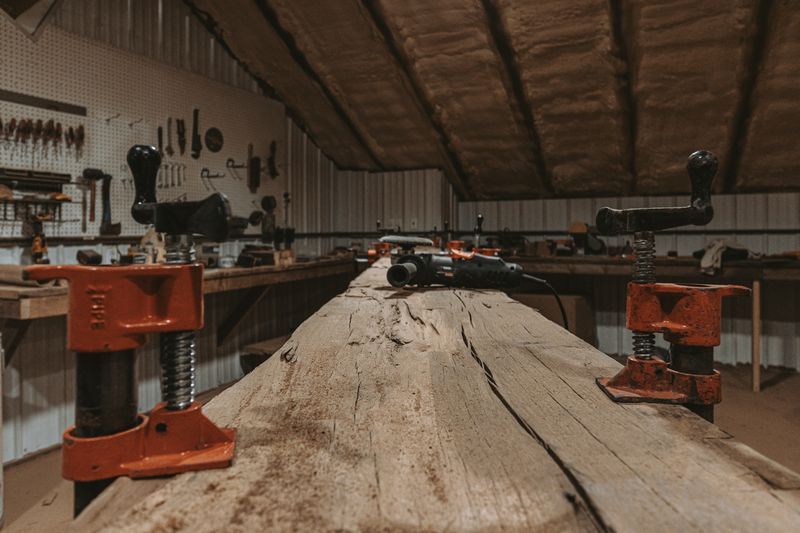How Dangerous Are Splits in Timber? Experts Weigh In
Understanding Timber Splits: Risks, Safety, and Expert Insights

If you’ve admired a beautiful old barn or the exposed beams in a timber-framed home, you’ve probably noticed something that might seem a little worrying at first glance—cracks or splits running along the beams.
These openings, often called “checks” or “splits,” can look alarming if you don’t know much about wood. Are they a warning sign that the structure is failing? Will they get worse over time?
Here's what experts say about this common wood characteristic.
Why Do Wood Beams Crack?
Before you worry too much, it’s important to know why cracks or splits happen in the first place. Wood is a natural material, and even after it’s cut down, it still reacts to its surroundings.
Cracks in beams often form during a process called "seasoning," which is when wood dries out after being freshly cut. As the wood loses moisture, it shrinks, but not evenly. The outer layers dry faster than the inside, leading to tension within the wood. This tension eventually causes cracks to appear.
Here are some things that make wood more likely to split:
The type of tree the wood comes from.
Some species, like oak, are more likely to split than others.
The size of the beam.
Bigger beams are more likely to have noticeable cracks.
How was the wood dried?
Wood dried in a kiln tends to crack less compared to wood that was air-dried.
The timber’s age.
Older beams, like those in historic structures, often have more cracks.
Humidity.
Changes in moisture levels speed up cracking.
Different Kinds of Cracks
Not all cracks are the same, and their impact may vary. Here are the most common types of cracks seen in wood beams:
Checks.
These are surface-level cracks that don’t go all the way through the beam. They’re very common and mostly affect how the wood looks.
Splits.
These cracks go deeper and can sometimes pass all the way through a beam.
Shakes.
Unlike seasoning cracks, shakes form while the tree is still growing. These can sometimes weaken the wood more than normal cracks.
End Splits.
These cracks appear at the ends of beams where moisture escapes faster. They’re often seen in large beams.

Should You Be Worried About Cracks?
Here’s the question everyone wants answered: Are these cracks dangerous? Our structural engineers and timber specialists say the answer is mostly reassuring.
Most cracks in wood beams are just cosmetic. The wood is strong and usually cracks in a way that doesn’t weaken its ability to hold weight.
Here’s a general guide to when cracks are not a problem:
- If they follow the natural grain (lines in the wood).
- If they show up on the top or bottom of horizontal beams.
- If they don’t happen near important joints or connections.
- If the beam isn’t twisting or warping.
Basically, cracks are a pretty normal part of having large wooden beams. Many experts even see them as part of the natural charm of using wood for construction.
When to Take Action
Although most cracks aren’t dangerous, there are some cases where you should call in a professional. These include:
- Cracks that run through important connection points, like where beams join together.
- Horizontal cracks on the sides of beams that are holding heavy vertical loads.
- Multiple severe cracks that make it look like the beam is splitting apart.
- Cracks that come with sagging or bending beams.
- New cracks that are quickly getting bigger.
- Cracks near areas with rot or insect damage.
How to Keep an Eye on and Protect Your Beams
If you’re concerned about cracks in your wood beams, here’s how experts recommend managing them:
Keep records.
Take photos and measurements of any noticeable cracks so you can track changes over time.
Control indoor humidity.
Sudden or extreme moisture changes can make cracks worse. Maintaining steady humidity levels can help.
Ask the pros.
If a crack looks serious, have a timber specialist or structural engineer check it out.
Skip DIY quick fixes.
Don’t fill big cracks with caulk or epoxy. These materials don’t move with the wood and can trap moisture, making things worse.
Restoring Old Timbers the Right Way
For anyone restoring an old timber frame structure, Bay & Bent can bring unique expertise. Our team works with historic beams that often have cracks and are aging. Instead of seeing these features as flaws, we look at each timber carefully to decide whether the cracks are harmless or need reinforcement. Our goal is to keep the wood’s natural character while making sure it’s strong and safe.
Our restoration process involves taking apart historic frames piece by piece, repairing or strengthening where needed, and then reassembling them, so they are ready to be shipped anywhere in the world. Our skill with traditional joinery methods and knowledge of wood behavior helps us handle cracks in the best way during these projects.
The Bottom Line
The truth is that most cracks in wood beams are completely normal and not something to worry about. These splits are part of how wood naturally ages and shifts with time. Rather than seeing them as defects, think of them as part of the wood’s story and charm.
Next time you spot a crack in a beam, remember that it’s probably just the wood being itself, adding to the unique beauty and history of the structure.









